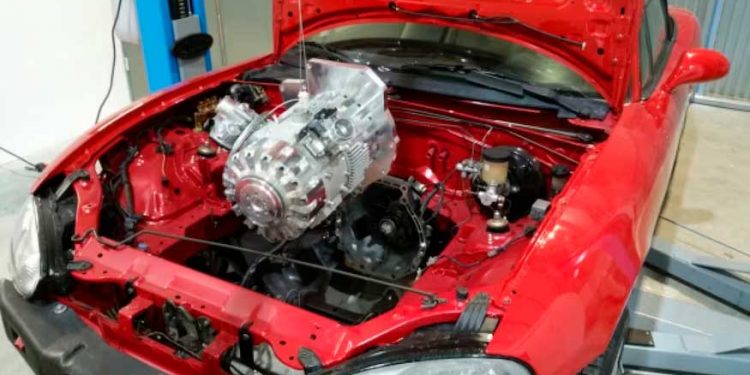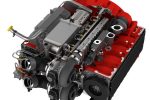Is This Weirdo “One-Stroke” 4-Cylinder, 8-Piston Engine the Next Big Thing?

Eight opposed pistons in four cylinders making 120 hp from 0.5 liter? Is it too good to be true?
Any oddball engine is clickbait crack for mechanical nerds, and the most compelling ones purport to introduce an entirely new combustion concept. “Not a four-stroke, not a two-stroke, a revolutionary one-stroke engine!” Well, that claim is utter hokum here. The combustion cycle is textbook two-stroke. Can we believe the other claims Granada, Spain-based INNengine is making for its e-Rex “Patented 1 Stroke” engine? Or the claimed output of 120 hp and 180 lb-ft, from a tiny 19-inch-long, 11-inch-tall, 84-pound engine that generates little or no vibration while acing its emissions tests? Here’s how the radical new engine concept is designed to work.
Is It Really A “1-Stroke?”
This is basically a four-cylinder, opposed-piston engine, similar in basic concept to the EcoMotors OPOC and Achates Power opposed-piston engines. It trades off the challenges and mass of two crankshafts for the increased friction and reduced torque generating nature of a pair of interlinked swashplates (INNengine calls them “cam tracks”) capable of delivering power at either end (or both) of the engine.
Each piston completes one back-and-forth motion in half an engine revolution. That means it executes both its compression/combustion, and exhaust/intake strokes twice per revolution, and by INNengine’s logic, two-strokes times half a revolution equals “Patented 1Stroke.” The name was chosen to distance the INNengine e-Rex from the challenges that have always dogged two-stroke engines.
How It Works
Instead of connecting rods attaching to a crankshaft, each piston moves up and down on a little piston-shaped cart of sorts. These feature two wide rollers that convey the combustion energy to the cam-track, and a third narrower one that’s trapped beneath a smaller diameter cam track that helps finish pulling the pistons apart after the combustion energy has exited the exhaust ports. The company claims the exhaust rushes out with sufficient force to create a vacuum capable of drawing in atmospheric intake charge, though supercharging is also possible.
Each main cam track is keyed to the common output shaft by means of an angled gear. Moving collars that engage these gears can change the timing of the left and right cam track, altering the intake/exhaust timing gap by up to 12.8 degrees, and thereby altering the compression ratio. This would be most useful in applications where the INNengine is used as a primary drive motor, pairing low compression (9.1:1) with super- or turbocharging, and higher compression (16.7:1) with low- or no boost operation for peak efficiency.
Two-Stroke Problems: Blue Smoke?
The oily blue smoke we associate with old Lawn Boy mowers, dirt-bikes, and Trabants came from mixing lubricating oil with the intake air to lubricate the (usually roller-type) crankshaft bearings. The smoke problem was largely been solved years ago by segregating the crankshaft lubrication from the intake and exhaust systems, and by employing direct fuel injection (this engine does both).
Two-Stroke Problems: Hydrocarbon And NOx Emissions?
Unlike Orbital two-strokes and others that utilize normal poppet valves, this one still uses cylinder ports near the bottom of each pistons’ stroke. That leaves very little time for the spent combustion gasses to exit and the fresh intake charge to enter, which is why turbo- or supercharging is often used. Even without forced induction, there’s basically no way to ensure oxygen doesn’t exit with the exhaust, rendering the traditional three-way gasoline engine catalytic converter ineffective.
Lean-NOx adsorber “trap” style catalysts like those used on diesels are costly, temperamental, and often require a separate fluid to periodically purge and regenerate them. A proposed solution to the above problem is operating the engine on hydrogen—a fuel that produces no hydrocarbons—and because an opposed-piston engine’s combustion chamber remains cooler, far less NOx is generated in the first place. But unless INNengine has figured out some means of lubricating the piston rings that doesn’t involve a hydrocarbon-based oil, trace hydrocarbon-based CO2 and other emissions will be emitted even when running on hydrogen.
Unique Benefits Of The Patented “1Stroke” Engine
Super smooth. All the reciprocating masses are perfectly balanced, with combustion forces acting equally in both directions, so vibration is negligible (the website shows a coin balancing on end).
Thermally efficient. Because the combustion presses equally on two pistons, most of the heat energy gets transferred to the pistons, rather than superheating a cylinder head that then requires extreme cooling.
Symmetrical power takeoff. Gearing the two cam tracks together eliminates the need for complex pushrod mechanisms to transfer energy to a common crankshaft or gearing to connect two crankshafts. As a bonus, if placed longitudinally, power could be split 50/50 and sent to the front and rear axles, providing AWD—at the cost of two transmissions.
Multi-fuel ready. The variable compression ratio makes the engine easily adaptable to a variety of fuels.
No valves, no deposits. Without port injection, traditional poppet valves can accumulate dangerous deposits, but without valves, this problem is eliminated.
Great specific power. Without the need for separate valvetrain and cylinder heads, and because of the simple connection between the cam plates (including the variable-compression regulator), the INNengine e-Rex is impressively power-dense.
Range-Extender Optimized
The above benefits make the INNengine e-Rex engine close to ideal for use as a range-extender. Such applications would likely require neither turbocharging nor variable compression, while the small size and inherent smoothness are ideally suited to the silent nature of an EV.
INNengine E-Rex “1Stroke” Engine Drawbacks
Friction of a V-8 or worse. It seems likely that 24 rollers interfacing with four cam tracks produces more friction than the oil-pressurized journal bearings on a common crankshaft in a typical engine. Then there are the eight pistons and their rings, although at least there is never any side load from an angled connecting rod.
Complex roller/thrust bearings. The engine contains the combustion forces trying to press the end cam tracks apart using roller thrust bearings at each end, which are considerably more expensive and complicated than anything found in a typical reciprocating-piston engine.
No torque leverage. A crankshaft multiplies the force of the combustion while transforming it into rotational motion in ways that a swashplate or cam track simply cannot, so we expect power and torque delivery characteristics will feel more like a rotary than a four-cylinder piston engine.
Miata Power!?
The INNengine team mounted a 500cc e-Rex engine in an NB-generation Mazda Miata and demonstrated it driving along (sharing no footage of full-throttle acceleration). This one was presumably gas-powered, and although the video claims the 120-hp output the website associates with an atmospheric e-Rex, there’s obviously a centrifugal supercharger mounted to the engine.
The sad truth facing the proponents of any engine this far outside the mainstream is that no matter how compelling the technology, the industry is not currently tooled up to make any of it and convincing it to do so with full electrification looming seems exceedingly unlikely.
Aviation, Marine, Stationary Power
These applications prize the INNengine e-Rex 1Stroke’s superpowers (small, light, smooth) far greater than even a PHEV ever could. Additionally, as long as attention is paid to oiling system pickups, the engine shouldn’t care which end is up, making it ideal for aerobatic applications.
https://www.motortrend.com/news/innengine-e-rex-1-stroke-hydrogen-powered-range-extender-engine/



